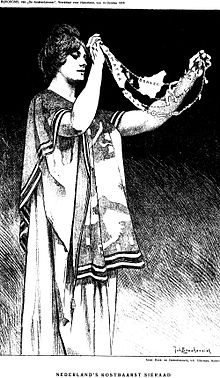
Back Hindia Blanda ACE Nederlands-Indië Afrikaans الهند الشرقية الهولندية Arabic Indies Orientales Neerlandeses AST Niderland Ost-Hindi Azerbaijani هولند دوْغو هیند آدالاری AZB Голландия Ост-Һиндостаны Bashkir Hindia Belanda BAN Галандская Ост-Індыя Byelorussian Hindia Nèderlan BEW
| History of Indonesia |
|---|
 |
| Timeline |
|
|
The Dutch East Indies,[3] also known as the Netherlands East Indies (Dutch: Nederlands(ch)-Indië; Indonesian: Hindia Belanda), was a Dutch colony with territory mostly comprising the modern state of Indonesia, which declared independence on 17 August 1945. Following the Indonesian War of Independence, Indonesia and the Netherlands made peace in 1949. In the Anglo-Dutch Treaty of 1824, the Dutch ceded the governorate of Dutch Malacca to Britain, leading to its eventual incorporation into Malacca (state) of modern Malaysia.
| History of Malaysia |
|---|
 |
|
|
The Dutch East Indies was formed from the nationalised trading posts of the Dutch East India Company, which came under the administration of the Dutch government in 1800. During the 19th century, the Dutch fought many wars against indigenous rulers and peoples, which caused hundreds of thousands of deaths.[4] Dutch rule reached its greatest territorial extent in the early 20th century with the occupation of Western New Guinea.[5] The Dutch East Indies was one of the most valuable colonies under European rule,[6] though its profits depended on exploitative labor.[7]
The colony contributed to Dutch global prominence in spice and cash crop trade in the 19th century, and coal and oil exploration in the 20th century.[7] The colonial social order was rigidly racial with the Dutch elite living separately from but linked to their native subjects.[8] The term Indonesia was used for the geographical location after 1880. In the early 20th century, local intellectuals conceived Indonesia as a nation state, setting the stage for an independence movement.[9]
Japan's World War II occupation dismantled much of the Dutch colonial state and economy. Following the Japanese surrender on 15 August 1945, Indonesian nationalist leaders Sukarno and Hatta declared independence, instigating the Indonesian National Revolution. The Dutch, aiming to re-establish control of the archipelago,[10] responded by deploying roughly 220,000 troops,[11] who fought the Indonesian nationalists in attrition warfare. The United States threatened to terminate financial aid for the Netherlands under the Marshall Plan if they did not agree to transfer sovereignty to Indonesia, leading to Dutch recognition of Indonesian sovereignty at the 1949 Dutch–Indonesian Round Table Conference.[12] Indonesia became one of the leading nations of the Asian independence movement after World War II. During the revolution and after Indonesian independence, almost all Dutch citizens repatriated to the Netherlands.
In 1962, the Dutch turned over their last possession in Southeast Asia, Dutch New Guinea (Western New Guinea), to Indonesia under the provisions of the New York Agreement.[13] At that point, the entirety of the colony ceased to exist.
- ^ Dick, Howard W. (2002). Surabaya City Of Work: A Socioeconomic History, 1900–2000 (Ohio RIS Southeast Asia Series). Ohio University Press. ISBN 978-0896802216.
- ^ "Page:The New International Encyclopædia 1st ed. v. 18.djvu/816 - Wikisource, the free online library". en.wikisource.org. Archived from the original on 24 December 2018. Retrieved 27 December 2018.
- ^ "INDES NEERLANDAISES Passeport 1931 DUTCH EAST INDIES Passport - Revenues - Delcampe.net". Archived from the original on 27 May 2015. Retrieved 27 May 2015.
- ^ Ricklefs, M. C. (2008). A history of modern Indonesia since c. 1200 (4th ed.). Stanford, Calif: Stanford University Press. p. 142. ISBN 978-0-8047-6130-7.
- ^ Ricklefs, M. C. (2008). A history of modern Indonesia since c. 1200 (4th ed.). Stanford, Calif: Stanford University Press. pp. 168–169. ISBN 978-0-8047-6130-7.
- ^ Hart, Jonathan (26 February 2008). Empires and Colonies. Polity. p. 200. ISBN 9780745626130. Archived from the original on 18 March 2015. Retrieved 19 July 2015.
- ^ a b Booth, Anne, et al. Indonesian Economic History in the Dutch Colonial Era (1990), Ch 8
- ^ R.B. Cribb and A. Kahin, p. 118
- ^ Robert Elson, The idea of Indonesia: A history (2008) pp 1–12
- ^ Ricklefs, M. C. (2008). A history of modern Indonesia since c. 1200 (4th ed.). Stanford, Calif: Stanford University Press. pp. 248–249. ISBN 978-0-8047-6130-7.
- ^ "How studying 1945-1949 wars can benefit Indonesia - The Jakarta Post". Histori Bersama. Archived from the original on 26 September 2023. Retrieved 21 November 2023.
- ^ "Decolonization of the Dutch East Indies/Indonesia | EHNE". ehne.fr. Archived from the original on 21 November 2023. Retrieved 21 November 2023.
- ^ Ricklefs, M C (1991). A History of Modern Indonesian since c.1300 (Second ed.). Houndmills, Baingstoke, Hampshire and London: The Macmillan Press Limited. pp. 271, 297. ISBN 0-333-57690-X.
Cite error: There are <ref group=lower-alpha> tags or {{efn}} templates on this page, but the references will not show without a {{reflist|group=lower-alpha}} template or {{notelist}} template (see the help page).


